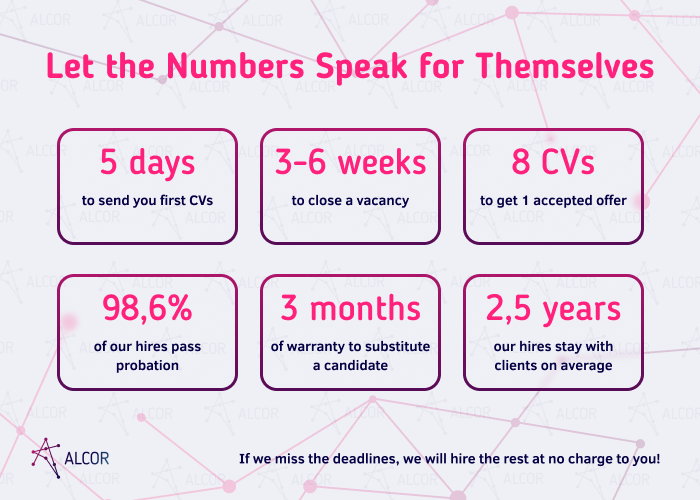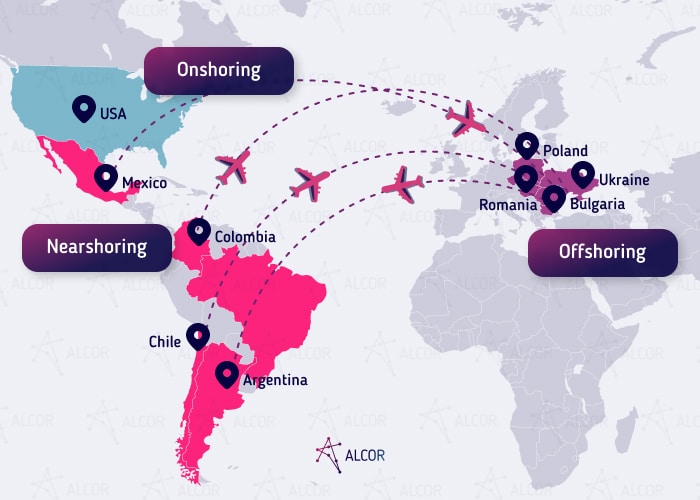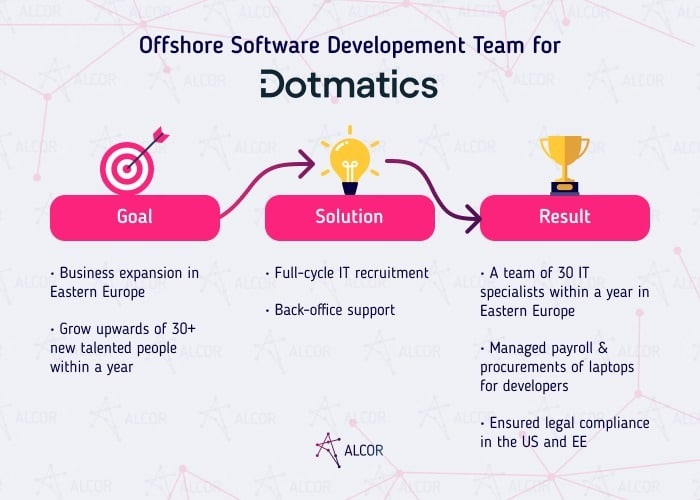Whenever tech leaders need to get experienced software developers on board, they choose between two business expanding models: offshoring and outsourcing. It’s no surprise, considering that this year, revenue in the IT outsourcing market is projected to reach $512.50 billion worldwide. Some companies may also view outstaffing as a viable alternative to outsourcing because of more effective communication with the team and enhanced management. But what model would fit your business needs best?
I’m Dmytro Ovcharenko, CEO & founder of Alcor, an R&D center and full-cycle IT recruitment service provider in Latin America and Eastern Europe. At Alcor, we can assemble an offshore software development team from 0 to 100 tech talents within a year for you.

In this article, I would like to focus on offshoring and talk about the different types — such as nearshoring, onshoring, and offshoring – the main pros and cons of these solutions, offshoring cases that made this staffing option the #1 on the IT market, and viable alternatives to offshore outsourcing.
Definitions of Onshore, Nearshore, and Offshore Outsourcing
Generally, outsourcing is a business practice that involves hiring an outside provider to perform a task or project. As a rule, an outsourcing provider runs the project from start to finish, handling every stage of software development. This collaboration model is often a temporary solution, well-suited to non-tech businesses lacking internal expertise or resources to develop web or mobile apps independently.
To make this solution for staffing crisp and clear, I’d like to describe it with the example of People.ai, an IT product company based in the USA that provides an AI platform for B2B sales. If People.ai needed to outsource programming, they would hire a third-party company, sign a contract with them, get some results, and pay for their services. However, they chose to delegate development via offshoring.
But what is offshoring? Offshoring, onshoring, and nearshoring are different types of outsourcing. The primary difference between them lies in geographical location. Let’s take a closer look at each of these approaches:

Onshoring
Onshoring is also a type of offshoring that involves relocating some tasks to providers in the same country but in a different region or city.
For instance, a company may have headquarters in California and open another onshore representative center in Texas or another state. This allows for cutting some expenses and extending the team.
Nearshoring
Nearshoring is a type of offshoring that allows CTOs to delegate business processes to neighboring countries.
For example, if a company headquarters is located in the United States and it decides to nearshore, they would find a vendor in Canada, Mexico, or any other country that shares a border with the US.
Offshoring
Offshoring presupposes transferring either a part of, or the whole business, to distant countries with big IT talent pools, reduced labor costs, and favorable tax incentives.
For instance, People.ai offshored their business operations to Eastern Europe and decided to open their own R&D office with Alcor. As a result, the new development hub for People.ai was ready in 1 month. Besides, we hired more than 25 developers within a few weeks, prepared all the necessary documents to comply their business with both local and American laws, and many more things.
IT Onshoring vs Nearshoring vs Offshoring
Now, I’ll outline the pros and cons of these collaboration models for US IT businesses, focusing on three key aspects: talent availability, costs, and time zones. Let’s begin with onshoring:
One of the main distinctions between onshoring vs nearshoring vs offshoring is talent availability. If you’re based in America and plan to onshore, you might have trouble with hiring because around 70% of American employers face difficulties in filling roles, according to the latest ManpowerGroup report. In this case, nearshoring and offshoring supplement skill gaps more efficiently.
Another difference between these three team extension options is cost efficiency. For US-based companies, onshoring is the most expensive type of offshoring because of high rent prices, taxes, and developer salaries – for instance, Middle JS Developers in the States make around $105,000 a year. In comparison, their Latin American counterparts charge 3-4 times less in general for the same services. It’s no surprise a whopping 87% of IT businesses considered nearshore outsourcing to cut costs.
But what is onshoring in terms of time zones and management? If you compare onshoring vs nearshoring vs offshoring, you’ll see that onshoring lets you receive quite fast feedback from the provider and supervise software development, due to the close alignment of time zones.
As you can see, onshoring provides tech companies with a rather limited number of IT talents and doesn’t stand out as a cost-saving option due to high salary and tax rates. Thus, nearshoring and offshoring seem to be more beneficial options for software development. But which approach would fit your business needs best? Let’s walk through each aspect of nearshoring vs offshoring IT companies need to consider before making the final decision:
-
Access to talented developers
When top managers need to bridge the tech-skills gaps in their companies, they compare offshoring vs nearshoring. Both collaboration models can open doors to millions of IT professionals ready to land jobs. For example, Latin America offers access to a vast pool of 1.75 million tech wizards. On the other hand, Eastern European countries such as Poland, Ukraine, Romania, and others connect international business with 1.5 million talented tech specialists.
-
Financial benefits
With nearshoring, cost-effectiveness is hardly measurable if you’re based in the US and nearshore to Canada. However, don’t dismiss the idea just yet. Some companies, for instance, decide to nearshore technology to Argentina, where Law 27,506 offers lucrative tax incentives until December 31, 2029. This includes a 60% reduction in corporate income tax for small companies, 40% for medium-sized firms, and 20% for larger enterprises. To top it off, software developer salary rates in Argentina are significantly lower than in the US and Canada. Case in point: a full-stack developer from Argentina gets ca. $40K-$60K a year, while a counterpart from the US charges $128K-$150K.
On the other hand, offshoring provides up to 70% of savings on expenses in such countries like Bulgaria, Romania, and Hungary, where Corporate Income Tax (CIT) rates are notably lower, ranging from 9% to 16%, compared to the US rate of up to 33%. Employing programmers under B2B terms in these regions also eliminates costly social contributions and taxes, offering financially efficient outsourcing alternatives. Similarly, the wages are also much lower in Eastern Europe than in the US: a Polish front-end developer earns around $44K yearly, while a dev from the US gets 2,5 times more – around $110K a year.
-
Time zones
What is nearshoring regarding time zones? It’s the solution that lets you have a similar time and get an immediate response from your provider. For instance, the US companies that opt for nearshore outsourcing in Mexico, benefit from the same time zone (UTC –5) as California. Similarly, nearshore software outsourcing to Colombia offers the advantage of a shared time zone with major US cities such as New York, Miami, and Washington D.C.
Yet offshoring offers an unexpected benefit of time differences – non-stop business processes. This is especially useful for companies that delegate technical support, because they are always available for their customers.
-
Local IT market growth
Last but not least, before starting development activities abroad, tech companies also consider IT market growth dynamics. Tracking these trends aids in evaluating the long-term sustainability and scalability of the target location. For example, the growth of the Latin American IT services market is fast and furious, growing at a CAGR of 12,26%. Take a glance at Mexico, where the software development market is valued at $28 billion, ranking it as the second largest in the region after Brazil.
As for offshoring, the Eastern European software development service market also doesn’t lag behind and demonstrates a promising growth rate at a CAGR of 12.88%. Have a look at Poland, where its IT industry ranks 7th in Europe with $8.7 billion in revenue.
| Aspect | Onshoring | Nearshoring | Offshoring |
| Talent availability | Limited | Abundant | Abundant |
| Cost savings | Low | High | High |
| Time zone | Similar or same | Similar or adjacent | May vary significantly |
All in all, for software development companies, both nearshoring and offshoring appear to be the most skill-friendly, cost and time-effective, and secure staffing options. However, traditional IT outsourcing entails significant pitfalls, such as a lack of control over the development process (often resulting in low software quality), no direct communication with the team, questionable dedication of software developers, hidden fees, risks to IP rights, data security concerns, and others.
You may ask yourself: can I still benefit from nearshore and/or offshore software development, bypassing all outsourcing risks? And the answer is yes.
Alternatives to Onshore, Nearshore & Offshore Outsourcing
No matter if you’re a startup or an enterprise, you need to take into account all the arguments of offshoring types that I have described above. So, how can you make a splash in a new market? Here are a few avenues to explore:
-
Software R&D Center = Your Own Software Team + EOR Service
If you want to make full use of offshoring and avoid tedious operational procedures, create your development hub with a vendor that can do it for you. For example, Alcor is the leading business process outsourcing services provider in Latin America and Eastern Europe. With us, nearshore outsourcing to Uruguay, Mexico, Chile, Argentina, and other locations is easily doable. Alcor offers a full cycle of back-office functions for IT product companies, such as:
1. IT Recruitment
In our tech recruitment department, we’ve got a stellar squad of 40 seasoned headhunters spread across Eastern Europe and Latin America. They’re the go-to experts for everything from spotting talent to smoothing out the onboarding process. Here’s how it works: we kick off with your meetings, where we hash out the dream candidate profile. Next up, we get creative crafting irresistible job ads that pop. Then, the candidates dive into interviews, tech tests, and English checks to find the best-fit team member for you. Finally, we present you only the finest candidates for your final nod.
Rest assured, we’ve got a solid promise on the table: we’ll have the first 20 software engineers on board within three months, and by the end of the year, we’ll have recruited over 100 skilled programmers. If we happen to miss these marks, we’ll make it right by covering the cost of hiring the remaining talent. Here are the stellar results of our cooperation with Dotmatics:

2. Employer of record
Alcor’s EoR service handles all the nitty-gritty tasks for your remote software team, such as:
- employ your software developers
- onboard/offboard them
- handle monthly payroll
- pay local taxes
- manage employee benefits
- comply with all local laws
It means you can wave goodbye to those headaches and concentrate on growing your business.
3. Full operational support
Apart from full-cycle IT recruitment and comprehensive EoR support, we also offer:
- your employer’s brand promotion in the local market;
- hardware procurement for your software research and development team;
- office lease, plus negotiations of the best price and contract terms;
- insurance assistance;
- background verification;
- legal services (stock options plans (SOP), migration services);
- visa support;
- IT support.
Our R&D services for your software company extend far beyond what’s listed here! Simply let us know your requirements for your local team, and we’ll make it happen.
-
Your own software development company
Launching your own software development company is also among the alternatives to IT outsourcing. By doing so, you establish a dedicated software development team that enables you to maintain all core operations in-house without concerns about data leakage risks or threats to IP rights. If opening a software development company solo, you’ll have to set up your legal entity in a foreign location and deal with a ton of documents to get your branch up and running. Not to mention that you’ll need to handle payroll, taxes, employee benefits, and other functions all by yourself. In addition, embarking on this journey in a new location comes with significant pitfalls, which vary depending on the scenario:
-
Limitations within Onshore
Sticking to onshore options means facing some tough realities. First off, finding top-notch tech talent might feel like searching for a needle in a haystack – it’s tough, time-consuming, and pricey. Moreover, the high demand for talent drives up operational costs and salaries, further exacerbating financial burdens for businesses. So, while staying onshore has its perks, compared to offshore and nearshore alternatives, onshoring tends to present more hurdles than advantages.
-
Pitfalls if Going Nearshore
When considering nearshore expansion, it’s crucial for US-based companies to select their destination carefully. For instance, while Canada offers a business environment akin to the US, its high costs are compounded by intricate local legislation and compliance requirements. At the same time, cost-efficient countries like Mexico, Colombia, or Argentina pose challenges when going solo. Mexico, known for its bureaucratic processes, and Argentina, with its complex legal framework for IT businesses, can be daunting for companies navigating them alone. Yet teaming up with a knowledgeable local partner can offer invaluable guidance, particularly in unfamiliar legal landscapes.
-
Challenges if Going Offshore
Similarly, if a US-based company decides to go offshore solo, it faces a big legal puzzle. Navigating through unfamiliar legislation resembles deciphering a perplexing puzzle. Each jurisdiction boasts its own set of regulations, and missteps could spell disaster. Within Europe, the legal landscape can vary widely from country to country, with diverse regulations governing areas such as taxation, employment, and data protection. For example, while some countries may have favorable tax incentives for businesses, others may impose stringent data privacy laws. Hence, partnering with a reliable partner emerges as the prudent choice.
-
Yourshoring
Among all alternatives to nearshore software development outsourcing, yourshoring offers a distinctive approach. This model involves tailoring remote teams to match specific business needs, ensuring seamless integration with existing teams. But is it worth paying extra for customization upgrades in outsourcing if, as a client, you still won’t be able to fully manage the team and development?
-
Crowdsourcing
Crowdsourcing in software development entails assigning tasks or projects to a large group of individuals, typically via an online platform. This approach taps into a global talent pool, enabling companies to efficiently complete projects while potentially reducing costs.
One example of a crowdsourcing platform is Huntly, a tech recruitment platform that aims to optimize the distribution of IT talent to meet industry needs. Huntly operates through a network of professional recruiters, facilitating cultural and professional matches between companies and tech talent worldwide.
